Getting your aquaponics system right takes time. However, it is worth making an effort to get your aquaponics filtration system right from the first time. Your reward will be a good quality yield of healthy crops with minimal intervention from you.
The volume of your growbed will be big enough to break down these solids given:
- You use worms
- Distribute the water evenly on the growbed
- Have a growbed of at least 12 inches deep
Let me explain this with an example,
If you have one growbed with a growing area of 16ft² and the depth is at least 12 inches, you can have a maximum of 16 pounds of fish. The solids will break down in the growbeds if you are using worms to help it break down. If you are using more fish, the solids waste is too much for the growbed to handle, and it will clog up.
Density = fish in pounds / growing area (at least 12″ depth)
16 pounds of fish / 16ft² growing area = 1
or
16 ft² growing area / 1 = 16 pounds of fish maximum
Why use an Aquaponics Solids Filter?
Bacteria in your water will convert the ammonia produced by your fish into nitrates, which are needed by the plants to ensure healthy growth. Check: What is aquaponics?
This is a natural process that occurs in nature as well as in your aquaponics system. The bacteria help to keep your fish healthy by converting toxic ammonia by turning it into nitrates, which your plants will use to grow.
However, the fish produce solids waste too. In growbeds, the worms will break them down if you have a system ratio below one.
If you are using any other growing method like DWC (floating rafts), vertical towers, or NFT, you need additional solids filtration.
- Grow beds: too many solids will clog up the growbeds and create aerobic zones. You can monitor this by watching the pH of your water go up. If solids build-up, aerobic zones are created, and nitrifying bacteria will die, this will lead to an increase in pH. Most people who are running a growbed system with a ratio that is too high (higher than 1) clean out the growbeds once a while.
- DWC (rafts): Solids removal in DWC systems is not needed if your density is below 0.3 (more on this in my book). Solid filtration is necessary if you have a higher density system. If you do not remove solids from a high-density system, it will create a sludge at the bottom of the troughs and create gasses and aerobic zones, which is bad for your nitrifying bacteria. Solids will attach themselves to the roots of the plants you are growing and block their nutrient uptake.
- NFT: If you are using an NFT system, your water needs to be very clean. This is probably the hardest part of aquaponics if you are using NFT. Therefore, I do not recommend using NFT with aquaponics if you are a beginner. If you do not remove all the solids (settable and suspending solids), you will run into problems soon. The solids will attach to the roots and prevent the plant from taking up nutrients. It can also block up the channels themselves.
Fortunately, this can all be prevented by filtering the water when it leaves the fish tank before it enters the growbeds, DWC, or NFT channels.
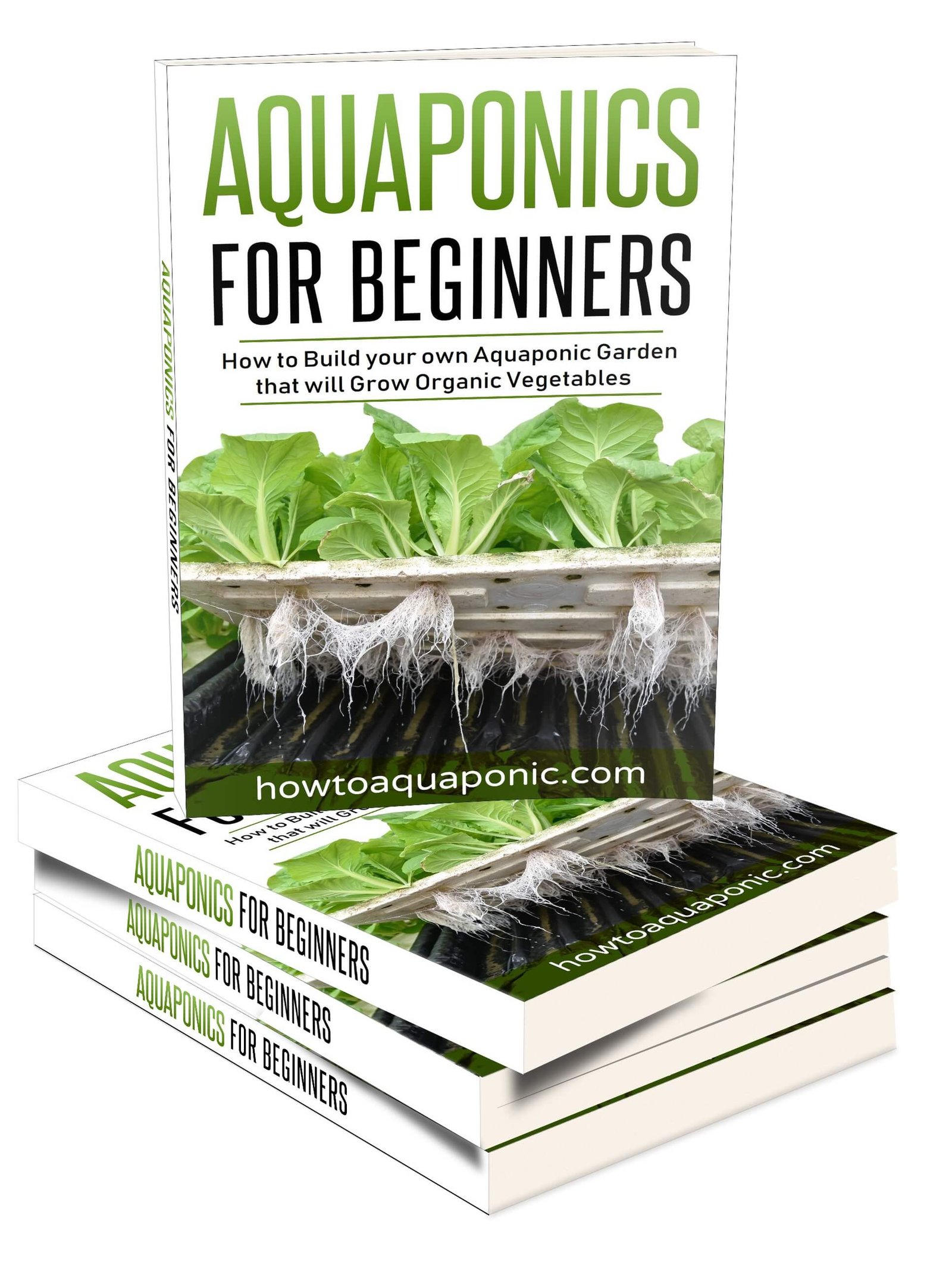 I have written a book that contains all the information you need to get started with aquaponics.
I have written a book that contains all the information you need to get started with aquaponics.
Don’t be the person that makes painful mistakes during your first aquaponics build!
It has 265 pages filled with information about aquaponics. It’s available in paperback or eBook format.
You can buy it here on Amazon.com
Different kinds of Solids
Before we get started, you need to know there are different kinds of solids. These are:
- Settable solids
- Suspended solids
- Floating solids
We will get rid of the settable solids by using a solids separator. This is a device where the solids have the time to settle to the bottom. This can be a swirl filter, radial flow filter, or a clarifier. The solids will settle over time, hence the name solids settler.
Suspended solids are harder to remove. They are light and therefore do not settle to the bottom of a solids separator. You have to capture them using another filtering method. Some people use bird netting to catch these solids. Others use mechanical filtration (screen or drum). If you are using growbeds, you don’t have to worry about these kinds of solids because it’s not that much. If you are using DWC or NFT you need to catch these suspended solids.
Floating solids float at the top of your fish tank. They do not get sucked up through an SLO (solids lifting overflow). Therefore they do not end up in the growing area. To get rid of these, you need to ‘break’ them using the return line of your pump. The water will splash on these solids and break them down, probably into suspended solids.
Next, you need to know the difference between a separator and a filter because they are not the same.
As previously mentioned, a separator separates the solids from the water using time. The solids will be allowed to settle down at the bottom where they will be drained. An important factor with using separators is the retention time. The water should be at least 20 minutes in your solids separator (or one-third of your flow rate per hour). This means if you have a flow rate of 150 gallons per hour, your solids separator needs to have a capacity of 50 gallons (150/50= 0.33 -> 0.33 * 60 minutes = 20 minutes).
Let’s start with describing the solids separators first:
Solid Separators
Swirl Separator (Vortex)
These are separators that are shaped like a barrel. You can either choose to go with a commercial conical bottom or use a 55-gallon drum. The conical bottom will allow the solids to collect at the bottom more efficiently, but they are expensive. They can be found at your local pond store.
Hobby aquaponics setups use 55-gallon drums as their vortex separator, which is an excellent option.
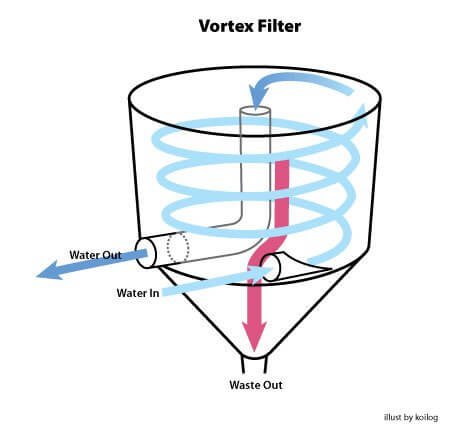
The water comes in halfway down the barrel wall. The motion of the water will create a swirl or vortex, and given enough time (retention time), the solids will settle at the bottom, and the clean water will exit from a pipe at the top.
Clarifier
A clarifier is a solids separator that uses time to let the solids settle at the bottom. This is done by using a separator plate in the middle of a water reservoir. The water reservoir can be anything from a barrel to a rectangular shape. As long as it is big enough to keep the retention time above 20 minutes.
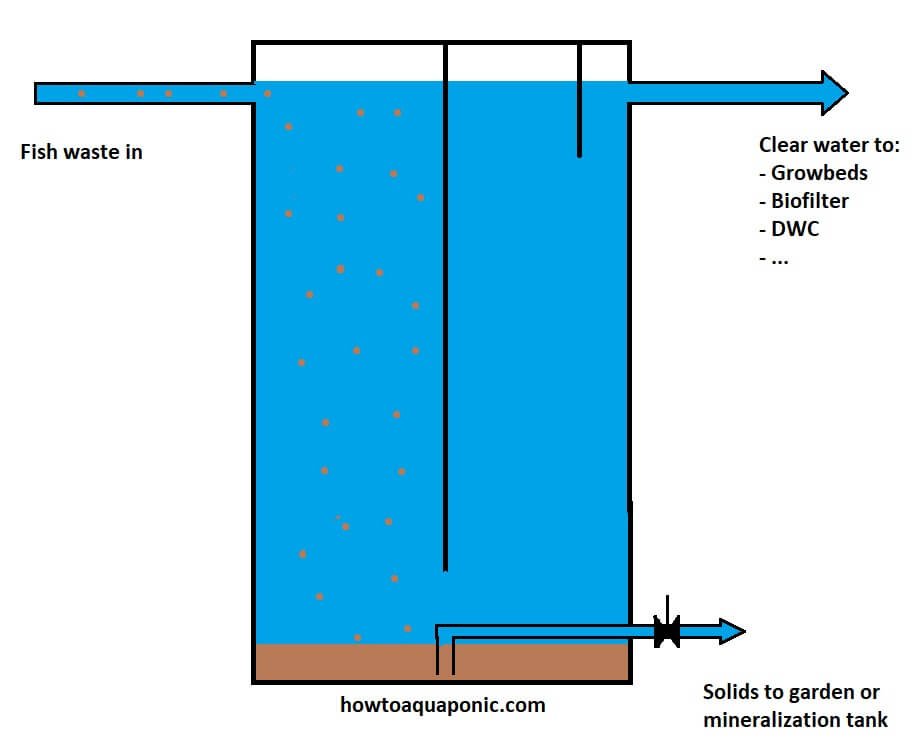
I have made a video about how a clarifier works. You can watch it here.
I have made a separate post about clarifiers in aquaponics. You can read it here.
Radial flow separator
The radial flow separator, also called the radial flow filter or radial flow settler, is the most used filter in aquaponics. It’s more efficient than using a vortex or clarifier but is a little bit more complicated.
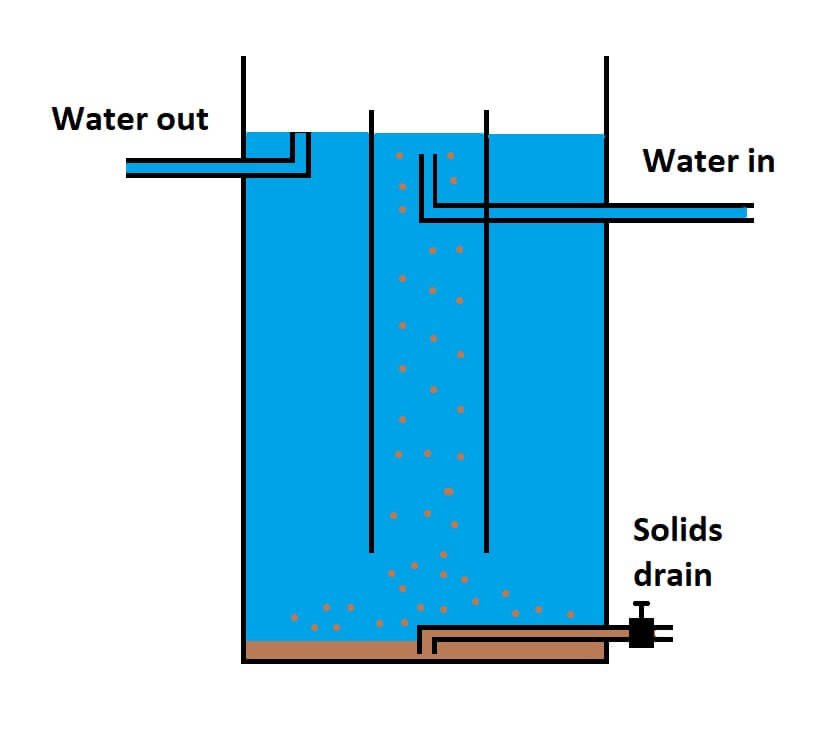
Solid Filters (mechanical)
Solid filters filter out the suspended solids as well as the settable solids. If you have a large system, it might be a good idea to have a settler first and then a mechanical filter. The main reason for this is that most mechanical filters need to be cleaned manually. With a separator, you can open a valve and drain the solids.
Raft Filters
The first one is a raft filter. In the image, you can see a small raft filter. It’s made out of Matala mesh sheets which need to be manually cleaned when the solids accumulate.
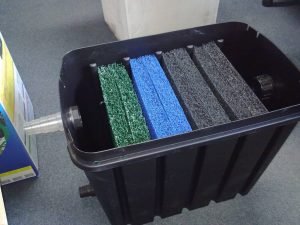
When the filter media gets clogged up, water will flow over the top of the mats, which will give it overflow protection.
Bird netting
Bird netting is a very popular solids filtration method in large aquaponics systems. The UVI system used these bird netting in combination with a clarifier to get rid of the solids.
The solids trapped in the bird netting will also serve as additional mineralization. The only downside to using bird netting is that it’s not easy to clean. The UVI system uses a cleaning station that they designed themselves and used high-pressure cleaning nozzles to remove the suspended solids from the netting.
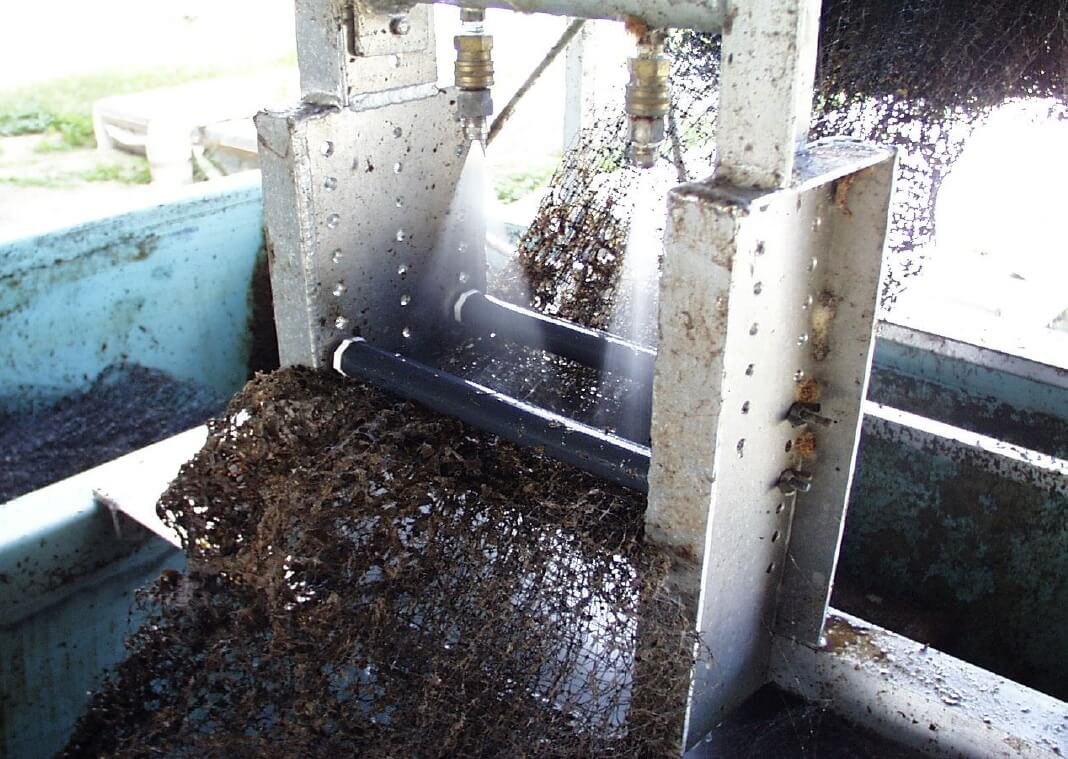
Screen filtration
Screen filtration of Sieve filters is a method that is not widely used in aquaponics. I have not seen any systems that use these screen filters. I have only seen them being used in koi ponds.
The water will flow over the screen, and the solids will stay on top while the water will drain to the other side. The diameter of the mesh plays a significant role in how much of the fine the solids that you will catch. In koi ponds, they use a 300 micrometer (um) stainless steel mesh.
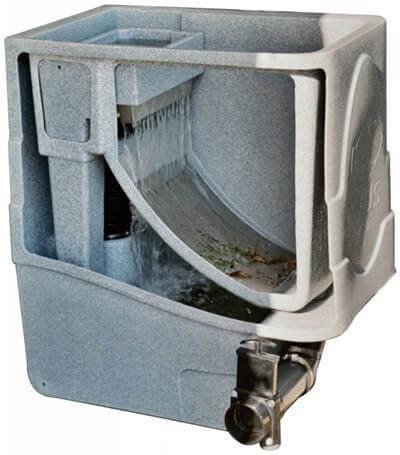
Filter sock filtration
In a small system, you can use a filter sock. I do not recommend these for large installations. They are useful to test how many solids are passing your primary filtration system.
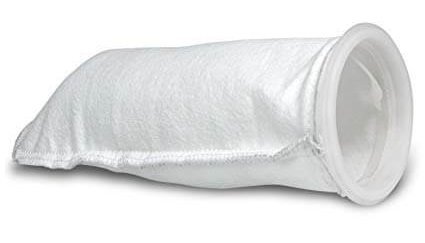
Conclusion
Solid waste particles are heavier than water and will settle given the opportunity. This makes it easier to remove them and protect your system. However, it is worth noting that you can reduce or even eliminate the number of particles in your system just by following a few simple rules:
- Don’t overfeed your fish; this will prevent fish food from clogging your pipes.
- Don’t use cheap fish food; it won’t help your fish, and it will increase the amount of waste.
- Don’t have too many fish! Always calculate fish numbers based on the size of the fish when they are adults. Too many fish equals more waste than the plants, or your system can handle.
If you are not sure about the quality of your fish food or the filters, take a look at the roots of your plants. If they are slimy and grey or brown, then there is too much debris in the tank; you need to reduce and change the fish food. Getting this one factor right should eliminate the need to add any filtration system unless you’re planning to go into large scale production.
Read more:
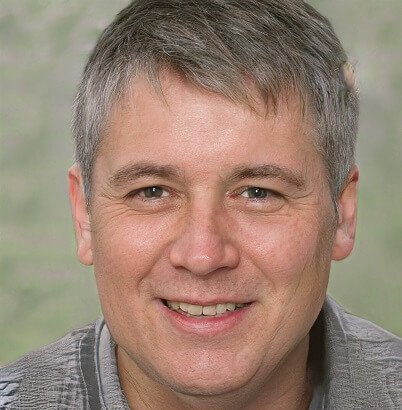
Nick loves building, managing and giving others advice on aquaponics. He created this website to do just that. He is the author of Aquaponics for beginners. If you got a question contact him here or read more on the about page here.
